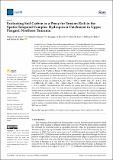Evaluating Soil Carbon as a Proxy for Erosion Risk in the Spatio-Temporal Complex Hydropower Catchment in Upper Pangani, Northern Tanzania

View/
Date
2021-10-15Author
Amasi, Aloyce
Wynants, Maarten
Kawala, Remigius
Sawe, Shovi
Blake, William
Mtei, Kelvin
Metadata
Show full item recordAbstract
Land use conversion is generally accompanied by large changes in soil organic carbon
(SOC). SOC influences soil erodibility through its broad control on aggregate stability, soil structure
and infiltration capacity. However, soil erodibility is also influenced by soil properties, clay mineral ogy and other human activities. This study aimed to evaluate soil organic carbon as proxy of soil
erosion risk in the Nyumba ya Mungu (NYM) catchment in Northern Tanzania. Soil organic carbon
(SOC) was measured by an AgroCares scanner from which the soil organic matter (SOM) was derived
using the conversional van Bemmelen factor of 1.72. A regression analysis performed between the
measured loss on ignition (LOI) values and SOM from the AgroScanner showed a strong positive
correlation in all land use classes (LOIFL R
2 = 0.85, r = 0.93, p < 0.0001; LOICL R
2 = 0.86, r = 0.93,
p = 0.0001; LOIGL R
2 = 0.68, r = 0.83, p = 0.003; LOIBS R
2 = 0.88, r = 0.94, p = 0.0001; LOIBL R
2 = 0.83,
r = 0.91, p = 0.0002). This indicates that SOC from the soil scanner provided a good representation of
the actual SOM present in soils. The study also revealed significant differences in the soil aggregate
stability (WSA) and SOM stock between the different land use types in the Upper Pangani Basin.
The WSA decreases approximately in the following order: grassland > forest land > bare land >
cultivated > bush land. Land use change can thus potentially increase the susceptibility of soil to
erosion risk when SOC is reduced. Since WSA was directly related to SOM, the study indicates that,
where formal measurements are limited, this simple and inexpensive aggregate stability test can be
used by farmers to monitor changes in their soils after management changes and to tentatively assess
SOC and soil health.
